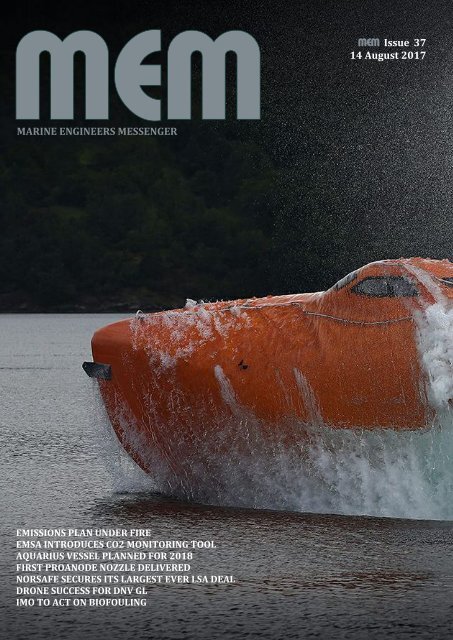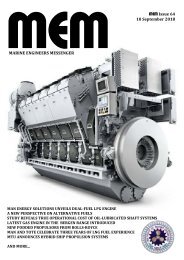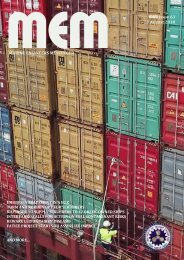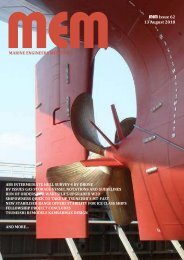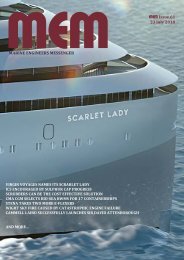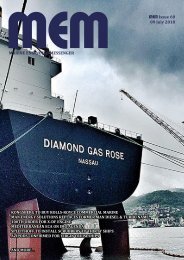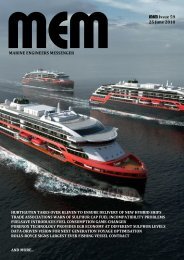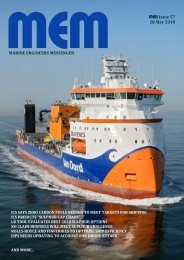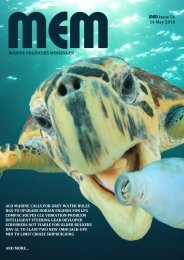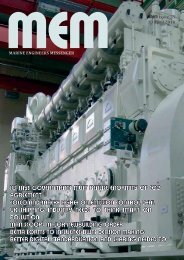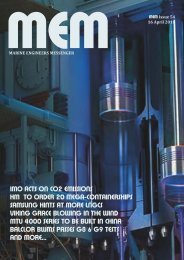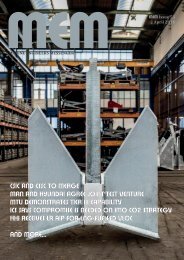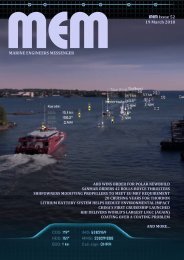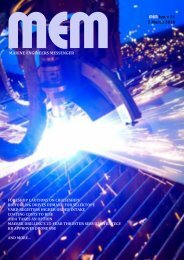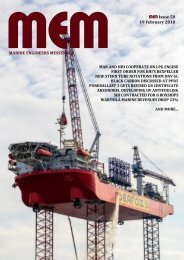MEM37
Marine Engineers Messenger Volume 2 Issue 37
Marine Engineers Messenger Volume 2 Issue 37
- No tags were found...
Create successful ePaper yourself
Turn your PDF publications into a flip-book with our unique Google optimized e-Paper software.
MEM<br />
MEM<br />
MARINE ENGINEERS MESSENGER<br />
Issue 37<br />
14 August 2017<br />
EMISSIONS PLAN UNDER FIRE<br />
EMSA INTRODUCES CO2 MONITORING TOOL<br />
AQUARIUS VESSEL PLANNED FOR 2018<br />
FIRST PROANODE NOZZLE DELIVERED<br />
NORSAFE SECURES ITS LARGEST EVER LSA DEAL<br />
DRONE SUCCESS FOR DNV GL<br />
IMO TO ACT ON BIOFOULING
MEM<br />
MARINE ENGINEERS MESSENGER<br />
MEM Issue 37<br />
14 August 2017<br />
Telegraph<br />
Arecently published survey has provided a clear snapshot of the shipping industry’s progress with<br />
ballast water management (BWM) system compliance.<br />
Based on input provided by owners and operators with BWM systems onboard their vessels, the ABSled<br />
report covers a range of topics, including installation, commissioning and operations of BWM systems.<br />
“It is important to share with all stakeholders the outcome of the ABS organised workshop on the issues<br />
and best practices with ballast water management systems,” says ABS Executive Vice President for Global<br />
Marine Dr. Kirsi Tikka. “When we hear directly from owners and operators, we are better able to<br />
understand the challenges in the operation of the systems, and for those systems which are operational,<br />
what practices are being followed.”<br />
To form an accurate picture of the current progress with BWM compliance, owners and operators with<br />
installed ballast water management systems were surveyed and invited to participate in the workshop.<br />
Survey results from approximately 30 owners and operators were aggregated to help identify trends and<br />
understand common practices while maintaining anonymity.<br />
In analysing the responses, ABS learned that 57% of the systems installed on the vessels were being<br />
operated. The remaining systems were either deemed ‘inoperable’ or considered ‘problematic.’<br />
The report reveals that some of the major challenges that shipowners and operators face with BWM<br />
systems are related to software, hardware and the crew’s ability to operate the systems correctly. System<br />
operators have had to develop plans to keep up with hardware maintenance and maintain an inventory of<br />
spare parts on a vessel.<br />
A recurring concern expressed by many owners relates to the chemical consumables used for<br />
determining residual oxidants in the ballast water. Proper storage and handling is critical to the operation<br />
of systems employing total residual oxidant (TRO). Another major takeaway from the workshop was the<br />
importance and necessity of maintaining an effective training strategy to ensure crew members can<br />
operate these systems properly and safely. Improved training methods and system manuals will decrease<br />
the number of issues that stem from operational errors.<br />
“This comprehensive report, based on feedback from our workshop, is an important assessment of the<br />
readiness of industry when it comes to ballast water compliance,” says ABS Director for Environmental<br />
Performance Thomas Kirk. “It is important that the practices which are being used successfully by some<br />
vessel owners are shared with others in the industry.”<br />
Readers can download the insightful report by clicking here.<br />
MARINE ENGINEERS MESSENGER<br />
SHIP TECHNOLOGY NEWS TO 8544 DECISION MAKERS<br />
EVERY TWO WEEKS<br />
Click here for more information about our favourable advertising rates or<br />
email: mem@seabornecomms.com<br />
3
EMISSIONS<br />
MEPC 71 EMISSIONS DECISION UNDER FIRE<br />
The UN’s International Maritime Organisation’s (IMO) plan to cut shipping’s climate emissions has been<br />
criticised by the Marshall Islands and lobby group Transport & Environment.<br />
Speaking to Politico magazine, Marshall Islands transport minister Mike Halferty said the outline strategy<br />
represents only ‘modest’ progress. “Much more rapid progress will need to be made at the second working<br />
group in October,” he said.<br />
The Marshall Islands is a prominent member of the IMO, holding the world’s second-biggest shipping<br />
registry while being one of the most vulnerable countries to rising sea levels.<br />
Countries meeting at the IMO’s environment committee MEPC71 agreed to ‘headings’ to be included in a<br />
strategy, which itself will be the first step of a broader plan to cut greenhouse gas emissions. The details of<br />
each section are to be decided at a meeting in October, and a draft strategy agreed by 2018. However, the<br />
strategy will not be finalised until 2023.<br />
The seven headings, or titles of each chapter of the strategy, cover the level of climate ambition and guiding<br />
principles for the shipping industry; possible measures for short, medium and long-term action; barriers to<br />
action, supportive measures and technical cooperation; and a plan for a review of the strategy.<br />
Shipping is one of the fastest growing sources of transport emissions and is projected to account for 17% of<br />
global emissions by 2050. But, despite the IMO being first tasked with addressing ship GHG emissions by the<br />
Kyoto Protocol some 20 years ago, shipping is the only industry in the world not subject to climate measures.<br />
Lobby group Transport & Environment’s shipping director Bill Hemmings (left)<br />
said: “Disagreement over how to distribute efforts and the potential costs of measures<br />
remain the biggest obstacle to progress. On a positive note, there was a strong<br />
delegation of Pacific Island nations. These countries, so vulnerable to climate change,<br />
are leading calls for an ambitious reduction target and urgent measures. In any case, as<br />
long as the IMO does not deliver a robust global deal to reduce shipping GHG, the<br />
inclusion of shipping in the EU ETS must remain on the table.”<br />
Meanwhile, a proposal to bring forward the target of improving the efficiency of<br />
new ships’ designs could be decided on next year. The IMO is being called on to<br />
advance the 2025 target date to 2022 following evidence that the current design<br />
efficiency standard, known as the EEDI, is too relaxed to drive ship efficiency. A new independent study for<br />
T&E found recent improvements in the design efficiency of new ships fell back last year.<br />
According to a CE Delft study the average design efficiency of ships built to carry bulk products, crude oil<br />
and natural gas was worse in 2016 than in 2015. The share of new ships complying<br />
with future efficiency standards also decreased in 2016 and the design efficiency of<br />
carrying consumer goods and general cargo appears to be stagnating after a period<br />
of improvement.<br />
The study also reiterated previous findings that a significant proportion of new<br />
ships are over-complying with the EEDI – indicating that the standard’s<br />
requirements need strengthening if it is to stimulate the uptake of new technologies<br />
and drive efficiency improvements.<br />
T&E’s shipping officer, Faig Abbasov (right), said: “Making new ships more<br />
efficient saves both fuel and carbon emissions. It is a no brainer. But the current<br />
EEDI requirements are so weak that ships built in 2016 are becoming less efficient.<br />
If the IMO is serious about reducing shipping emissions the very first thing it should do is tighten the EEDI<br />
requirements.”<br />
DNV GL RELEASES UPDATED NOX TIER III COMPLIANCE GUIDE<br />
Classification society DNV GL has developed a new brochure to offer a set of best<br />
practices for the design of ships subject to NOx Tier III requirements. It also<br />
offers guidance on the considerations that should be taken into account at the<br />
newbuilding stage.<br />
To ensure the success of any newbuilding plan, shipowners should carefully<br />
consider the future operation of their vessels in the newbuilding planning stage,<br />
including the implications of the different technological solutions for reducing<br />
NOx emissions and how to fulfil the NOx Tier III requirements. In order to fulfil<br />
the stricter NOx Tier III emission limits, ship operators have the possibility of<br />
choosing from various options. The optimal compliance option will depend upon<br />
many factors, including a vessel’s individual trading pattern, engine size and<br />
speed. The brochure examines selective catalytic reduction (SCR), exhaust gas<br />
recirculation (EGR), the use of alternative fuels, internal engine modifications,<br />
4
direct water injection (DWI), fuel-water emulsion (FWE) and intake air humidification.<br />
Installing NOx Tier III-compliant technology can offer benefits beyond simply achieving compliance with<br />
emissions regulations. Demonstrating a company’s commitment to ensuring sustainable operations has become<br />
increasingly important. In addition, the installation of Tier III-compliant technology also goes hand in hand with<br />
direct financial benefits, as many major ports offer substantial discounts on harbour fees if a vessel complies<br />
with third party environmental schemes such as the ESI.<br />
EMSA INTRODUCES CO2 MRV TOOL<br />
EMSA, the European Maritime Safety Agency, has unveiled a monitoring, reporting and verification system to<br />
help reduce the industry’s CO2 emissions.<br />
THETIS-MRV marks the first of several steps in the EU’s efforts to include the maritime transport sector in<br />
its overall policy to reduce greenhouse gas emissions. The system will enable companies responsible for the<br />
operation of large ships using EU ports to report their CO2 emissions, as required by law from 1 January 2018<br />
under the EU’s Monitoring, Reporting and Verification Regulation.<br />
The move is expected to encourage the uptake of greenhouse gas emission-reduction measures within the<br />
maritime sector, as the emissions data will be made public and updated yearly.<br />
EMSA was tasked to develop a robust system for the monitoring and reporting of verified data on CO2<br />
emissions, annual fuel consumption and other energy efficiency parameters by the European Commission’s<br />
Directorate General for Climate Action. A four-year cooperation agreement between the two parties was signed<br />
in March 2016 mapping out the delivery of cost-efficient services based on the use of existing infrastructure<br />
and supporting arrangements, as well as proven concepts and expertise. Extending the possibilities of the<br />
original THETIS information system, EMSA designed a purpose-built monitoring, reporting and verification<br />
system. This THETIS-MRV system enables companies to work together with accredited verifiers to prepare<br />
monitoring plans in a voluntary module and, importantly, to release emission reports and documents of<br />
compliance to the European Commission and relevant flag state authorities using the mandatory module. Using<br />
the information submitted, the European Commission will publish annual aggregated data per ship covering<br />
fuel consumption, CO2 emissions and average energy efficiency indicators, among others.<br />
To maximise the impact of the regulation and minimise the administrative burden on shipping companies<br />
and operators, the rules apply only to ships above 5000gt which account for around 55% of ships calling at EU<br />
ports and yet represent around 90% of the total share of related emissions. Several consultations took place to<br />
ensure that the views of a broad range of technical experts, including NGOs and industry, were considered for<br />
the development of the system.<br />
EXHAUST TREATMENT<br />
WÄRTSILÄ TO SCRUB NEW JAPANESE BULKERS<br />
Two new 56,000dwt handymax bulk carriers being built by Japan’s Oshima Shipbuilding for Tokyo-based NYK<br />
Bulk & Projects Carriers Ltd. (NYK BP), will feature a Wärtsilä exhaust gas treatment system.<br />
The contract represents Wärtsilä’s first scrubber supply order from a Japanese company.<br />
“We are pleased and proud to be the supplier of choice for these two new ships, especially as it gives us an<br />
inroad into the Japanese market for exhaust gas cleaning solutions. The value proposition that Wärtsilä<br />
presented was clearly the deciding factor in the award of this contract,” says Sigurd Jenssen, Director, Exhaust<br />
Gas Cleaning, Wärtsilä Marine Solutions.<br />
5
“Together with Oshima Shipbuilding, we compared performance, price and fuel costs of comparable<br />
products developed by other companies before choosing Wärtsilä’s scrubber system,” said a representative<br />
from NYK BP.<br />
The equipment is scheduled for delivery to the yard in July 2018. The first vessel is due to be delivered to<br />
NYK in the 4th quarter of 2018, and the second in the 1st quarter 2019.<br />
RENEWABLE ENERGY<br />
AQUARIUS VESSEL PLANNED FOR 2018<br />
Eco Marine Power (EMP) has begun preparing its Aquarius Marine Renewable Energy (MRE) solution for sea<br />
trials. This preparatory work will lead to the world’s first installation of an integrated rigid sail and solar power<br />
system for ships using EMP’s patented technologies including the EnergySail.<br />
The company cites this as a major step forward towards a more sustainable future for shipping and is<br />
expected to result in the wider deployment of EMP’s solutions on ships ranging from coastal cargo vessels to<br />
bulk ore carriers and cruise ships.<br />
Currently underway is a feasibility study involving several large bulk carriers including the Belgrano, Nord<br />
Gemini and Bulk Chile. For each ship, an estimate of the propulsive power that could be provided by EnergySail<br />
will be prepared according to the routes they operate on. The total amount of solar power that could be<br />
installed on each vessel will be determined. On-board testing and data collection will also be undertaken as<br />
required.<br />
Following the feasibility study, one ship will be selected for sea trials, during which a trial Aquarius MRE<br />
configuration will be installed and evaluated during an 18-month period.<br />
Aquarius MRE is an advanced integrated system of rigid sails, marine-grade solar panels, energy storage<br />
modules and marine computers that will enable ships to tap into renewable energy by harnessing the power<br />
provided by the wind and sun. The use of these alternative sources of power and propulsion will reduce fuel<br />
consumption, lower air pollution and cut CO2 emissions. The rigid sails used by Aquarius MRE are based on<br />
EMP’s EnergySail technology. These renewable energy devices can even be used when a ship is at anchor or in<br />
harbour. Each EnergySail can be configured with a mix of sensors, photovoltaic panels or other power<br />
generation devices.<br />
Commenting on this latest development Greg Atkinson, Chief Technology Officer and Founder of Eco Marine<br />
Power said, “It’s great that we are able to co-operate with Hisafuku Kisen and we very much appreciate their<br />
cooperation in helping us move this important project towards sea trials. We also appreciate the support of our<br />
strategic partners and together we believe Aquarius MRE will pave the way to the widespread adoption of<br />
renewable energy on ships.”<br />
6
Chikashi Yamane, President of Hisafuku Kisen stated,<br />
“Our company is pleased to be part of this exciting project<br />
which is leading the way towards the use of renewable<br />
energy related technologies on ships.”<br />
The production of each EnergySail to be used during<br />
the sea trials will be undertaken at the workshops of<br />
Teramoto Iron Works in Onomichi, Japan. This company<br />
was also involved in the production of rigid sails in the<br />
1980s and has extensive experience regarding the<br />
manufacturing of high quality marine fittings for ships.<br />
Strategic partners in the Aquarius MRE Project include<br />
KEI System Co. Ltd, The Furukawa Battery Company and<br />
Teramoto Iron Works Co. Ltd. However, EMP is also in<br />
discussions with several companies including potential<br />
investors about their possible involvement in the project<br />
and would like to hear from other companies that wish to<br />
be involved during the sea trials phase of the project.<br />
PRIME MOVERS<br />
DUAL FUEL FOR NEW ATAIR<br />
Wärtsilä is to supply the engines for a new LNG fuelled<br />
research vessel being built for the German government.<br />
Wärtsilä will also supply exhaust cleaning systems based<br />
on selective catalytic reduction (SCR) technology and the<br />
LNGPac system for complete fuel gas handling.<br />
The vessel is under construction at the Fassmer<br />
shipyard in Germany for Bundesamt für Seeschifffahrt und<br />
Hydrographie (BSH), the Federal Maritime and<br />
Hydrographic Agency.<br />
The new 75m Atair will replace her 30-year-old<br />
namesake, and be the first German research vessel<br />
operating on LNG fuel.<br />
The full scope of supply is two six-cylinder Wärtsilä<br />
20DF dual-fuel engines capable of running on either LNG<br />
or conventional liquid fuels, one six-cylinder Wärtsilä 20<br />
engine, two exhaust cleaning systems, and a Wärtsilä<br />
LNGPac fuel storage, supply, and control system.<br />
The engines will have Tier III classification since the<br />
dual-fuel engines comply with this classification when<br />
running in gas mode, and all the engines will be compliant<br />
when operating on diesel because of the Wärtsilä SCR<br />
systems. Furthermore, the engines will be double<br />
elastically mounted to minimise the noise. This special<br />
Wärtsilä technique will enable the ship to fulfil the DNVGL<br />
classification society’s ‘Silent R’ rating, thus allowing the<br />
sonar equipment to be used without disturbance from<br />
underwater radiated engine noise.<br />
“Our dual-fuel technology is unique when it comes to<br />
small bore medium speed engines, and the extended<br />
service intervals and economic fuel<br />
consumption of the Wärtsilä<br />
20DF engine enable<br />
lower operating<br />
Type Approved<br />
to IMO MEPC<br />
227 (64)<br />
MARIPUR NF<br />
CLARIMAR MF<br />
ACO Marine's new MARIPUR NF and CLARIMAR MF advanced<br />
wastewater management systems are the merchant, naval and<br />
megayacht sectors most effective solutions for meeting<br />
stringent IMO MEPC 227(64)<br />
rules.<br />
Compact and economical<br />
with the lowest operating<br />
costs of any sewage<br />
treatment plant, CLARIMAR<br />
MF and MARIPUR NF are<br />
proven to reduce<br />
coliform bacteria, TSS,<br />
COD, nitrogen and<br />
phosphorous content to<br />
levels significantly below<br />
the mandated requirements.<br />
Mark Beavis - Managing Director<br />
Nádrazňi 72, CZ -15000 Praha 5,<br />
Czech Republic<br />
Tel: +420 724 011 775<br />
Email: mbeavis@acomarine.com<br />
Web: www.acomarine.com<br />
7
costs than is possible with high speed engines. We have worked closely with the Fassmer shipyard and are<br />
proud to have once again been selected to supply the machinery and equipment for this important project,”<br />
says Lars Anderson, Vice President, Engine Sales, Wärtsilä Marine Solutions.<br />
“As the new Atair will be the first vessel in our fleet with LNG technology, we rely on the experience and<br />
expertise of Wärtsilä with respect to the engines and LNG tank equipment. With Wärtsilä’s dual-fuel and SCR<br />
technologies, the vessel will fulfil the IMO’s Tier III regulations in all operational conditions, whether sailing on<br />
LNG or on diesel fuel,” says Kai Twest, Head of Ships and Equipment Division at BSH.<br />
The Wärtsilä equipment is scheduled to be delivered to the yard in mid-2018, and the vessel will enter<br />
service in early 2020.<br />
WÄRTSILÄ ENGINES TO POWER NEW<br />
CHINESE RESEARCH VESSELS<br />
Two four-cylinder Walong with a nine-cylinder and<br />
eight-cylinder Wärtsilä 26 engines have been selected<br />
by the Huangpu Wenchong and Wuchang shipyards to<br />
power two new research vessels under construction for<br />
the China Ocean Mineral Resources R&D Association<br />
(COMRA).<br />
Each engine, mounted to minimise noise and<br />
vibration, will also feature Wärtsilä NOx Reducer (NOR) to<br />
comply with the International Maritime Organisation’s (IMO)<br />
Tier III regulations. Wärtsilä retractable thrusters will also be<br />
supplied to the vessels.<br />
When delivered, the 98m Da Yang 2 Hao, will be used for scientific surveying, including deep sea extreme<br />
environment detection and supported by a 90m long manned submersible support mother ship. Both vessels<br />
are scheduled for delivery in March 2019.<br />
PROPULSION<br />
SCHOTTEL’S NEW NOZZLE DEBUT<br />
Astilleros Gondan has commissioned the first LNG-powered dual fuel tug ever built in Europe propelled by two<br />
powerful Schottel thrusters fitted with the new SDV45 nozzle.<br />
The 40.2m DUX is the first tugboat of a series of three designed by the Canadian company Robert Allan to<br />
serve Statoil’s LNG gas terminal in Hammerfest, Norway.<br />
A pair of SRP 630 CP Schottel Rudderpropellers will provide main thrust to the vessel, while<br />
manoeuvrability will be enhanced with a 250kW STT 170 FP bow thruster. The vessel is deigned to achieve a<br />
maximum service speed of 15kts, with a high bollard pull of 107t, although an indirect steering force of 167t at<br />
10kts can be achieved. A key feature is a breaking force exceeding 200t.<br />
DUX is the first vessel to feature Schottel’s new VarioDuct SDV45 nozzle, developed to enable high-power<br />
applications along with reduced fuel consumption.<br />
According to the German propulsion<br />
specialist, the SDV45 nozzle marks a<br />
substantial progress in terms of a<br />
vessel’s overall efficiency compared to<br />
other nozzle products. In combination<br />
with a compatible propulsion unit, fuel<br />
savings of up to 10% are possible at a<br />
certain speed, while maintaining a high<br />
rate of bollard pull. Furthermore, due to<br />
the nozzle’s relatively small diameter, it<br />
is ideally suited for operation in shallow<br />
waters.<br />
Louis Dreyfus Armateurs Group is<br />
expected to soon provide a second<br />
reference for the nozzle, having ordered<br />
the SD45 for a wind farm service vessel<br />
building at the Cemre Shipyard, in<br />
Turkey. Three Schottel<br />
Rudderpropellers will feature the new<br />
nozzle.<br />
8
FIRST PROANODE NOZZLE DELIVERED<br />
The first steerable thruster with the newly developed Schottel<br />
ProAnode has been ordered from undisclosed Russian interests.<br />
The ProAnode nozzle form and position is claimed to “set new<br />
standards in corrosion protection”, thereby extending the lifecycle of<br />
the thruster. Furthermore, moving the position of the anode from the<br />
outside surface into the cross-section of the nozzle tail leads to<br />
subsequent operational benefits, such as reduced flow interference,<br />
resulting in fuel savings.<br />
Schottel’s core idea was to remove the anodes from the outside surface of<br />
the nozzle, where they are prone to being knocked off by flotsam, such as<br />
wood or ice, or even by slight ground contact. Loss of the anodes is usually<br />
only discovered during maintenance downtime, by which time corrosion<br />
might already have become a problem. Plus, depending on the nozzle’s<br />
diameter and the anode’s material, anodes for up to five years<br />
cathodic protection against corrosion can be integrated into the<br />
nozzle. This enables a reduction of additional anodes for the<br />
hull or other thruster parts.<br />
The new position in the tail of the nozzle not only shields<br />
the anodes, but also offers additional operational potential as<br />
it contributes to the optimal hydrodynamic flow of the nozzle.<br />
As its smooth overall surface reduces flow interference, it<br />
meets the customer’s need for highly efficient propulsion<br />
systems. It results in lower fuel consumption and pays off in<br />
terms of reduced operating costs.<br />
MOORING<br />
MACGREGOR MOORING SYSTEM FOR<br />
MOHESHKHALI VESSELS<br />
MacGregor has inked and equipment, fabrication, engineering and<br />
project management contract for a complete mooring and riser<br />
system to serve vessels operating at the Moheshkhali floating liquefied natural gas (LNG) terminal.<br />
The order is part of an EPCI contract to provide Excelerate Energy the mooring and gas transfer system for<br />
a floating storage and regasification unit (FSRU). MacGregor's scope of supply includes on-vessel equipment,<br />
Flintstone mooring connectors, as well as project management for the fabrication, procurement and project<br />
management of the complete mooring and riser system for the FSRU operated by Excelerate Energy.<br />
"We are happy to be involved in this floating LNG terminal project. This order is a natural step in our<br />
strategy to expand to the FSRU market with one of world's leading players," says Michel van Roozendaal,<br />
President, MacGregor. "This order proves the combined strength of both MacGregor and Flintstone".<br />
MacGregor acquired the majority of Flintstone shares last autumn.<br />
COMPRESSORS<br />
TMC TO SUPPLY COMPRESSORS TO UTKILEN TANKERS<br />
TMC Compressors (TMC) has won a contract from AVIC Dingheng Shipbuilding to supply marine compressed<br />
air systems to two 9900dwt chemical tankers the yard is building for the Norwegian shipping company<br />
Utkilen.<br />
Under the contract, TMC will manufacture and deliver a complete Smart Air compressor working air system<br />
to each of the two vessels, plus air driers and filters to the onboard service and control air system. TMC’s Smart<br />
Air compressors are claimed to offer 50% energy savings compared to conventional compressors, reducing<br />
both operational expenses and harmful emissions to air.<br />
Under a separate contract, TMC will deliver two 235kW feed air compressors to both vessels’ nitrogen<br />
systems.<br />
“It is encouraging to see that an increasing number of yards and shipowners are paying more attention to<br />
OPEX than before. Our Smart Air compressors are highly energy efficient and provide significant cost savings<br />
throughout the lifetime of a vessel. The maritime and shipping industries have a shared responsibility to<br />
reduce harmful emissions to air, and we are pleased to play a part in this,” says Per Kjellin, managing director<br />
of TMC.<br />
The vessels are scheduled for delivery in 2019.<br />
9
FUELS AND LUBES<br />
SHELL LUBRICATION FOR<br />
THE WORLD'S LARGEST<br />
CONTAINER SHIP<br />
Orient Overseas Container Line<br />
(OOCL) has appointed Shell Marine<br />
to provide lubricants to the<br />
21,413TEU OOCL Hong Kong,<br />
currently the world’s largest<br />
containership,<br />
Drawing on its over 30-year<br />
track-record with OOCL, Shell<br />
Marine laid out its portfolio of<br />
cylinder oil options to match the<br />
owner’s operating profile and fuel<br />
grade expectations as well as to<br />
protect the main engine against cold<br />
corrosion and optimise feed rates.<br />
The vessel operates MAN Diesel &<br />
Turbo’s G-type engines.<br />
“As a supplier, we have considerable experience with the G-type engines. It was crucial that we shared our<br />
knowledge with OOCL at the outset, and that they could offer feedback in the dialogue that ultimately led to the<br />
optimal product selection,” says Jan Toschka, Shell Marine Executive Director.<br />
In addition to Shell Marine’s lubricants, Shell LubeMonitor has been deployed onboard OOCL Hong Kong –<br />
which includes a cylinder oil condition monitoring service that uses shipboard and laboratory analysis to help<br />
optimise engine performance and enable predictive maintenance. The programme includes access to Shell tools<br />
and expert advice to help customers strike and maintain an acceptable balance between feed rate related<br />
cylinder oil costs and wear-related cylinder maintenance expenses. It is now enhanced with a new software<br />
package, Marine Connect, designed to transfer onboard analysis data to the Shell experts easily and securely.<br />
“Working towards the selection of the right cylinder oils is a collaborative process that needs to satisfy<br />
engine-maker approvals, as well as the client’s requirement for proven performance,” Toschka adds. “Our<br />
technical support needs to be based on the same principles, so that ship operators can monitor the condition of<br />
the oil and equipment in the field, and plan effectively when remedial action is necessary.”<br />
SURVIVAL SYSTEMS<br />
NORSAFE SECURES ITS LARGEST EVER OFFSHORE LSA CONTRACT<br />
Norsafe has secured its largest ever offshore contract to supply lifesaving appliances to ENI’s Coral South<br />
floating LNG (FLNG) facility located in Area 4, approximately 50km from the Mozambique coast.<br />
The order is to deliver 8 freefall systems containing five GES 50 MKIII with HD-50 davits and 3 x GES 45 with<br />
HD-45 davits, to the FLNG facility under construction by Samsung Heavy Industries. The davits will be delivered<br />
in November 2018 and the<br />
lifeboats in February 2021.<br />
The GES 50 MKIII freefall<br />
lifeboat will take up to 70<br />
persons and can drop from a<br />
height of 47 metres with the<br />
GES 45 taking up to 60<br />
persons, having a maximum<br />
drop height of 40 metres.<br />
This represents a<br />
significant milestone for<br />
Norsafe and, combined with<br />
other large orders secured<br />
recently, means that the<br />
company has booked more<br />
than 100 million NOK in<br />
July; an outstanding<br />
achievement given the<br />
current market situation.<br />
10
“I am delighted that Norsafe has secured such a prestigious contract to supply the first FLNG facility in<br />
Africa. It is testament to the dedication and hard work of our global teams that we have managed to secure so<br />
much business this year,” said Dag Songedal, CEO for Norsafe.<br />
“We will continue to listen to our clients and develop products and services to meet their requirements in a<br />
cost-effective way,” he added.<br />
RUDDERS<br />
BECKER RUDDERS FITTED FOR ODFJELL NEWBUILDS<br />
Odfjell and Hudong-Zhonghua Shipbuilding have selected Becker Schilling TT Rudders for a series of<br />
49,000dwt chemical tankers. The Schilling TT Rudders, equipped with an optimised rudder bulb, were selected<br />
to provide the optimum propulsion efficiency without impacting manoeuvrability. Additional to a firm order of<br />
four tankers for oil products and chemicals there have been signed four options. The first vessel is expected to<br />
be delivered in June 2019.<br />
SHIP DESIGN<br />
ROLLS-ROYCE AND MYSTIC COOPERATE ON ECO-FRIENDLY CRUISESR<br />
Rolls-Royce has signed a deal with WestSea Yard, part of Martifer Group, to equip an expeditionary oceanic<br />
cruise ship for Portuguese based cruise company Mystic Cruises.<br />
The vessel, World Explorer, will be the Mystic’s first expeditionary Antarctic cruiseship and the first of<br />
several ships to be built by the Portuguese company for its expeditionary cruise line. The design is the result of<br />
several years of study and development to create the perfect balance between luxury, comfort, efficiency and<br />
environmental friendly operation.<br />
Mário Ferreira, Mystic Cruises, CEO said: “These are very exciting times for us, this project is something that<br />
we’ve been working on for some time, crafting it to perfection to meet our clients’ and the market’s needs.<br />
World Explorer will be the first of our expeditionary cruise ships. She will offer passengers a once in a lifetime<br />
experience of exclusivity and personalised service visiting the vast frozen landscapes of Antarctica and small,<br />
exclusive ports around the world.<br />
“Antarctica offers a unique setting for expeditionary cruises, and we’ll offer the opportunity to explore this<br />
amazing region with all the comfort and luxury of a five-star plus hotel. Aboard the World Explorer, guests will<br />
have the opportunity to marvel at the beauty of the landscape, while enjoying all the amenities of a luxury hotel<br />
with a personalised service, where staff will know their name and preferences.<br />
11
“Being one of the last unspoiled and untouched regions in the World, Antarctica poses a unique challenge for<br />
cruise companies to offer the high-quality service that guests are used to in other areas, while being<br />
environmentally sustainable. We are very pleased to be working with an industry leading company such as<br />
Rolls-Royce. Since we started our partnership the results have been very positive, and we believe that we made<br />
the correct call in selecting them. For us it’s essential to have a sustainable, efficient and environmental friendly<br />
solution. That is why we opted for the hybrid technology that Rolls-Royce proposed.”<br />
Rolls-Royce has supplied two Bergen, C25:33L8P main engines and a Bergen C25:33L6P auxiliary dual<br />
generator. These connect to a Low Voltage AFE SAVeCUBE Power Electric System which allows the engines to<br />
operate at variable speeds maximising their efficiency for the required power. Rolls-Royce is also providing the<br />
automation and control system, and the complete Promas propulsion system with two CPP propellers<br />
integrated with two flap rudders, also steering gears and tunnel thrusters.<br />
John Roger Nesje, Rolls-Royce, Vice President, Power Electric Systems – Marine said: “Our experience of all<br />
aspects of ship design and construction, has allowed us to help Mystic Cruises, carefully consider World<br />
Explorer ‘s operational profile and identify the optimum combination of technologies to use to reduce emissions<br />
and achieve improved performance and fuel economy.”<br />
The 126m long, 9300gt ship will have an operating cruise speed of 16kts with a strengthened hull and<br />
propellers for traversing ice.<br />
AUTONOMOUS SHIPPING<br />
DRONE SURVEY SUCCESS FOR DNV GL<br />
DNV GL surveyors have carried out the classification society’s first offshore drone survey on the<br />
semisubmersible vessel Safe Scandinavia, a 25,383gt tender support vessel owned and operated by Prosafe,<br />
supporting Statoil’s drilling operations off the coast of Norway.<br />
Using camera-equipped drones, DNV GL’s drone pilots checked the TSV’s fairleads and their connection with<br />
the vessel’s two columns as part of the intermediate survey.<br />
“Innovation is one of Prosafe’s core values. We are very pleased that we chose to try the drone survey, as it<br />
helped us optimize our survey requirements and allowed us to save significant amounts of time and money.<br />
Normally, this kind of operation would cause disruption to our client for several days. The drone survey took<br />
only a few hours and was just as effective,” says Ian Young, Chief Operating Officer at Prosafe.<br />
“This was a great opportunity for us to demonstrate our drones’ abilities to check the condition of remote<br />
external components in challenging offshore conditions. The inspection only required the semi-submersible to<br />
de-ballast, then we flew the drone approximately 25 metres below the main deck to check the condition of the<br />
fairleads and their connections to the columns that hold up the TSV. With wind speeds of approximately 15<br />
knots, this went very well and the survey showed that the fairleads and their connections were in a good<br />
condition,” explains Cezary Galinski, Project Manager Classification Poland at DNV GL.<br />
The classification society has carried out multiple drone surveys on both ships and offshore units, inspecting<br />
many areas on board, ranging from tanks and cargo holds to external<br />
structures such as jack-up legs. The inspection of such spaces can<br />
be both costly and time consuming, and even in some instances<br />
potentially<br />
12
dangerous. Using drones to visually check the condition of remote structural components can significantly<br />
reduce survey times and staging costs, while at the same time improving surveyor safety.<br />
DNV GL has built a network of trained drone pilots based in Gdynia, Piraeus, Singapore, Houston and<br />
Shanghai. This allows drone survey inspections to be offered from any of these hubs. At the same time, DNV GL<br />
is developing guidelines and updating our rule set to reflect the use of remote inspection techniques.<br />
ABS JOINS AUTONOMOUS SHIPPING ALLIANCE<br />
Classification Society ABS has joined the Unmanned Cargo Ship Development Alliance to advance autonomous<br />
shipping.<br />
“Increased digitization, advanced technologies and new levels of connectivity are changing the way the<br />
maritime industry operates,” says ABS Greater China Division President Eric Kleess.<br />
“In the coming years, we will see significant changes in the way ships are designed and built, with a strong<br />
drive to develop autonomous vessels especially in China. As a key member of this alliance, ABS is aligned<br />
closely with industry to support safer and more sustainable maritime operations.”<br />
The Unmanned Cargo Ship Development Alliance, chaired by HNA Technology Group, was officially launched<br />
at the end of June and expects to deliver the unmanned cargo ship by October 2021.<br />
“Through this collaborative effort, we will apply the latest technologies to develop a new autonomous ship<br />
concept,” says HNA Technology Group Vice Chairman Li Weijian. “The newly formed alliance is advancing new<br />
innovations in ship design and operations, and working to promote the safe adoption of these assets in the<br />
market.”<br />
SMART SHIPS<br />
HHI ISSS CUST OPERATING COSTS FOR NAVIGATORS<br />
Hyundai Heavy Industries (HHI) has developed an<br />
Integrated Smart Ship Solution (ISSS) capable of<br />
optimising the navigation and management of ships<br />
Said to be the first of its kind in the global<br />
shipbuilding industry the ISSS standardises ways of<br />
navigation depending on the level of skill and<br />
experience of navigators. It collects and analyses<br />
real-time information on navigations to enhance<br />
efficiency and safety of ships. The solution is<br />
expected to cut annual operating costs by 6%.<br />
Developed to coincide with the introduction of<br />
IMO’s e-Navigation, a strategy to bring about<br />
increased safety of navigation in commercial<br />
shipping through better organisation of data on ships<br />
by 2019, HHI says the demand for smart ships is<br />
expected to grow further.<br />
Smart ship technology is a system that helps<br />
ships’ efficient operation by using ICT and big data.<br />
HHI developed the initial smart ship technology in<br />
2011 and has applied the system to about 300 ships. Moreover, in May this year the shipbuilding group signed a<br />
memorandum of understanding on establishing a partnership in the smart ship sector with the National<br />
Shipping Company of Saudi Arabia (Bahri).<br />
Lloyd’s Register’s Luis Benito, Innovation, Strategy and Research Director, Marine and Offshore said: “HHI’s<br />
technology seeks to align with delivering the key benefits we believe the maritime industry will most benefit<br />
from through the adoption of connected, digital and autonomous technologies as the next generation of<br />
shipping embraces digitalization. According to Clarkson Research, about 6500 ships are to be ordered globally<br />
for the next five years. Considering the global shipbuilding market share HHI takes up now, ISSS is to be<br />
installed on approximately 700 ships for the comparable period.”<br />
ISSS is developed on the back of INTEGRICT which is Hyundai Electric’s, a newly spun off company of HHI,<br />
intelligence energy management system. ISSS provides a wide range of ship information to operators including<br />
optimal navigation routes and navigation speed along with a slope status of the front and back hull of a ship<br />
that minimize resistances a ship takes on voyage. The solution allows safer and more efficient management of<br />
ships by collecting and analysing energy data and monitoring status of engines and propellers. The ICT solution<br />
already completed field tests as well by being mounted on a 6,500 PCTC and a 250,000dwt VLOC.<br />
An HHI official said: “As we have always been, we will continue to exert our efforts to lead the global<br />
shipbuilding market with differentiated technological edges through the digital innovation.”<br />
13
COATINGS<br />
B+V ADOPT NEW HULL PREPARATION PROCESS<br />
German shipyard Blohm+Voss is applying a new hull surface preparation technology developed by Hubert<br />
Palfinger Technologies (HPT) that is claimed to “set new standards in quality and efficiency and makes a<br />
sustainable contribution to environmental and occupational safety.”<br />
The Hull Treatment Carrier (HTC) process, which will be applied to all repair and refit projects at the yard, is<br />
an automated application process that uses high pressure water at 3000bar to remove 1200m2 of existing<br />
coats per hour. B+V claim the process results in 30 per cent less paint required for recoats.<br />
Compared to common manual application techniques, the automatic surface preparation and coating<br />
process allows for “an exact and uniform colour composition”. This results in reduced consumption of the<br />
colour coating as well as a smoother application of the antifouling coat providing a less rough surface, which<br />
ultimately leads to fuel savings when the ship is in operation.<br />
A further advantage cited is reduced environmental impact due to a reduction in VOC emissions.<br />
The collaboration between the shipyard and Palfinger began in May 2016 with the first successful test runs<br />
on a 4045TEU Hapag-Lloyd containership Quebec Express<br />
When the vessel drydocked at Blohm+Voss, the coating was fully removed, partially using the HTC system.<br />
BIOFOULING<br />
IMO TO ACT ON BIOFOULING<br />
A new global project to help protect<br />
marine ecosystems from the negative<br />
effects of invasive aquatic species has<br />
been given the go-ahead for<br />
preparation.<br />
The GloFouling Partnerships<br />
project – a collaboration between the<br />
Global Environment Facility (GEF), the<br />
United Nations Development<br />
Programme (UNDP) and the<br />
International Maritime Organisation<br />
(IMO) – will address the transfer of<br />
aquatic species through the build-up<br />
of aquatic organisms on a ship’s<br />
underwater hull and structures.<br />
The project will focus on the<br />
implementation of the IMO Guidelines<br />
for the control and management of<br />
ships’ biofouling, which provide<br />
guidance on how biofouling should be<br />
controlled and managed to reduce the<br />
transfer of invasive aquatic species.<br />
Marine bio-invasions are the<br />
source of significant environmental<br />
and socioeconomic impacts that can<br />
affect fisheries, mariculture, coastal<br />
infrastructure and other development<br />
efforts, ultimately threatening<br />
livelihoods in coastal communities.<br />
The GloFouling project will build<br />
on the success of the GEF-UNDP-IMO<br />
GloBallast Partnerships project, which<br />
worked to build capacity to implement<br />
IMO’s Ballast Water Management<br />
(BWM) Convention. The BWM treaty<br />
addresses the transfer of potentially<br />
invasive aquatic species in the ballast<br />
water of ships.<br />
The new project will build capacity<br />
in developing countries to reduce the<br />
transboundary introduction of<br />
SAVE MILLIONS IN DRYDOCK<br />
COSTS AND OFF-HIRE TIME<br />
Hull of cruise ship after 5 years with Ecospeed coating with no replacement or major repair. This is the state<br />
of the hull when the ship came out of the water, without any cleaning or touch-up in drydock.<br />
When your hull coating never<br />
needs replacing or major repair,<br />
you can save a lot of money in drydock<br />
fees, off-hire time, materials and labour.<br />
Most hull topcoats are designed to be<br />
replaced once or twice every five years.<br />
The full hull coating scheme has to be<br />
fully replaced every 10 - 15 years down<br />
to bare steel.<br />
Over that time period, the coating<br />
degrades and becomes rougher until it’s<br />
no longer worth trying to patch it up.<br />
www.<br />
And it costs you a fortune in fuel to<br />
compensate for the additional hull<br />
friction.<br />
Imagine a coating that’s guaranteed for<br />
10 years and is expected to last 25<br />
without replacement or major repair. A<br />
coating that gets smoother over time,<br />
not rougher!<br />
Imagine coming into drydock after 3 or<br />
5 years and finding that your hull<br />
coating only requires a few minor<br />
touch-ups and doesn’t even need to be<br />
washed off.<br />
Call us today for a quote to convert your hull to Ecospeed or start off right,<br />
with Ecospeed, on a new build.<br />
EU Office<br />
Phone: + 32 3 213 5318<br />
Fax: + 32 3 213 5321<br />
info@ecospeed.be<br />
US Office<br />
Phone: + 1 727 443 3900<br />
Fax: + 1 727 443 3990<br />
info@ecospeed.us<br />
.be<br />
14
iofouling-mediated invasive aquatic species. Stefan Micallef, Director, Marine<br />
Environment Division, IMO, said: “IMO has been at the forefront of the<br />
international effort to tackle the transfer of invasive aquatic species by ships.<br />
Addressing ship’s hull fouling is a crucial step to protect marine biodiversity. The<br />
treatment of hulls to reduce fouling by aquatic organisms has the additional<br />
benefit of reducing greenhouse gas emissions, since the drag of ships is reduced.”<br />
The GEF, UNDP and IMO collaboration has already proved to be highly<br />
successful through its 3-tier (“Glo-X”) implementation model for driving legal,<br />
policy and institutional reforms, delivering capacity-building activities and<br />
encouraging technology transfer through public-private partnerships at the<br />
global, regional and national levels. The GloBallast project completed its work in 2017. The ongoing GloMEEP<br />
project is aimed at supporting the implementation of energy efficiency measures for shipping.<br />
The GloFouling Partnerships project concept was approved by the GEF Council in May 2017, with a total<br />
funding of US$6.9 million earmarked for implementation. The project is now going through a detailed<br />
preparation phase to be resubmitted to the GEF for endorsement before implementation can commence. The<br />
full name of the new project will be “Building Partnerships to Assist Developing Countries to Minimize the<br />
Impacts from Aquatic Biofouling” (GloFouling Partnerships).<br />
The GloFouling project preparation will be undertaken by the IMO Secretariat, which has invited interested<br />
Member States are encouraged to inform the Secretariat of their intention to participate in the new project as<br />
soon as possible.<br />
Andrew Hudson, Head, UNDP Water & Ocean Governance Programme, said: “GloFouling Partnerships will be<br />
an excellent opportunity to help tackle one of the key remaining vectors for the transfer of invasive aquatic<br />
species, which cause sizeable impacts on economies and livelihoods. GloFouling was the natural follow up to<br />
the GEF-UNDP-IMO GloBallast Partnerships programme which recently concluded after delivering a series of<br />
important achievements in reducing the transfer of harmful aquatic organisms through ships’ ballast water”.<br />
Chris Severin, Senior Environmental Specialist from the GEF, said: “The implementation of the GloFouling<br />
Partnerships will be instrumental in battling aquatic invasive species, and will not only lead to healthier more<br />
robust marine ecosystems, but also positively impact economic opportunities and the livelihoods of millions of<br />
people across the globe. I am confident it will be another success in the fruitful partnership between the GEF,<br />
UNDP and IMO”.<br />
MEM Marine Engineers Messenger<br />
Editor Patrik Wheater<br />
Contributions: Charlie Bartlett<br />
Publisher: Seaborne Communications Ltd<br />
Email: mem@seabornecomms.com<br />
Web: www.seabornecomms.com<br />
The information published in MEM does not<br />
necessarily represent the views of Seaborne<br />
Communications Ltd. The publisher makes no<br />
representation or warranty as to the accuracy or<br />
correctness of the information or accepts<br />
responsibility for any loss, damage or other liability<br />
pertaining to the information published in this<br />
newsletter.<br />
©2017 Seaborne Communications Ltd<br />
15


